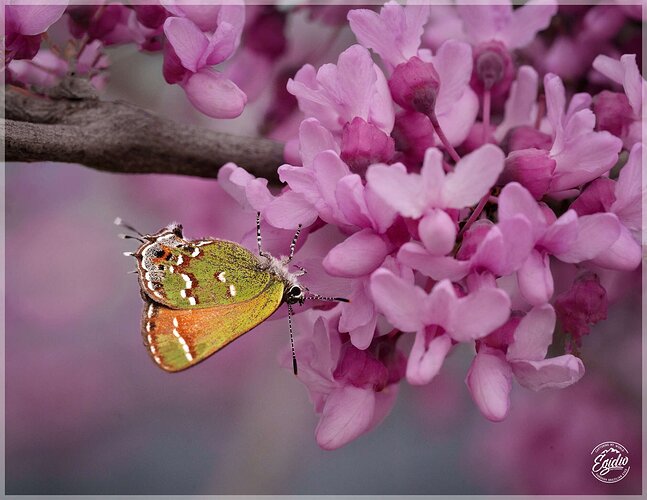Repost (above)
Original post (above)
Image Description
With this repost, I feel there is a need to make clear that the Image Description section refers to the first image I posted with the butterfly flipped upright instead upside down. By using the original Hairstreak position, I am now using a different title for the post. I tried to address some of the feedback I received in the various comments provided. It was interesting to note that the more I worked on the revisions, the more the original orientation with the butterfly upside down felt more comfortable to my eyes. Also, as a couple of you pointed out, the Hairstreak does nectar upside down. In my images, I try to maintain nature without changing it much. This attempt with the first submission proved I should have followed that procedure. There was a reason the Hairstreak was upside down. The cropping in this revision is 8.5x11, as suggested. I do like that format. I had to clone out some stray flowers on the left side of the image. Also in the URC, there were some very dark stems that kept bugging me. I attempted some cloning there in order to minimize the distraction. The dark and light pink colors are natural in rosebud flowers. I did apply some burn on a couple of petals that were too bright.
ORIGINAL IMAGE DESCRIPTION
Spring weather has been around Texas since late February. Even some state flowers (Bluebonnets) were spotted along highways back then. During one of my walks with friends, I noticed that redbuds were also blooming very strongly in several locations. With the abundance and thick coverage those flowers bring, I set out to get a few macro images of them in early March. While doing that, I noticed a tiny Juniper Hairstreak butterfly in my viewfinder photobombing my original compositions. A firm believer in “embracing the moment,” I began following the butterfly as it quickly moved from flower to flower. Once I had noticed it, it was easy to follow because its color stood out among the pink of the redbud flowers. For those not familiar with the tiny creatures, with their wings wide open, this butterfly’s size is between 0.75" - 1.25" (1.9 cm - 3.1 cm). With its wings closed, as in this photo, the Juniper Hairstreak butterfly is barely the size of a dime (10-cent US coin, or 0.7" or 1.8 cm). It would have been impossible to even attempt multiple shots for focus stacking. This is a single macro image among several I made that day using a tripod. This was my preferred photo because the entire butterfly is mostly all in focus. With the butterfly nearly being perpendicular to the lens camera, and because of its small size, I was able to get almost the entire butterfly in the same focus plane. A small detail: this was all viewed upside down. No, not me, but the butterfly. ![]() However, no matter how much I looked at the original composition, my eyes and head just could not wrap themselves around that inverted position. So, the image I have here is horizontally flipped. The original view is shown in Version 2.
However, no matter how much I looked at the original composition, my eyes and head just could not wrap themselves around that inverted position. So, the image I have here is horizontally flipped. The original view is shown in Version 2.
Version 2 (original view)

EXIF
Type of Critique Requested
-
Aesthetic: Feedback on the overall visual appeal of the image, including its color, lighting, cropping, and composition.
-
Technical: Feedback on the technical aspects of the image, such as exposure, color, focus and reproduction of colors and details, post-processing, and print quality.
Specific Feedback and Self-Critique
Here are four issues I often struggle with in my photos:
(1) Saturation - does it appear natural to your eyes?
(2) Cropping - is the butterfly placement appropriate in the frame? Is there enough room on the right side of the frame?
(3) Distractions - I tried to eliminate some very bright areas that were distracting. Did I miss anything that you find distracting?
(4) Sharpness - too much, too little?



